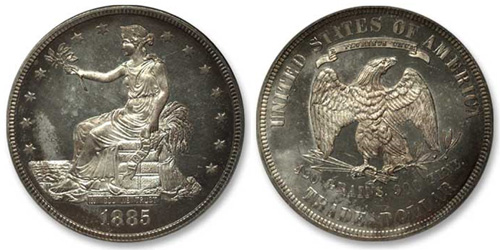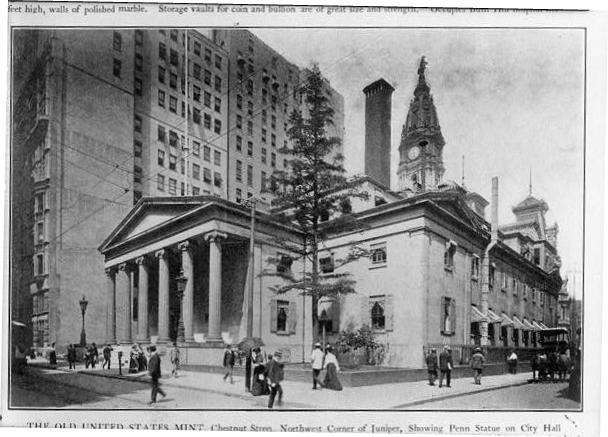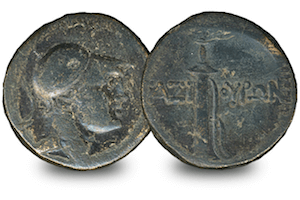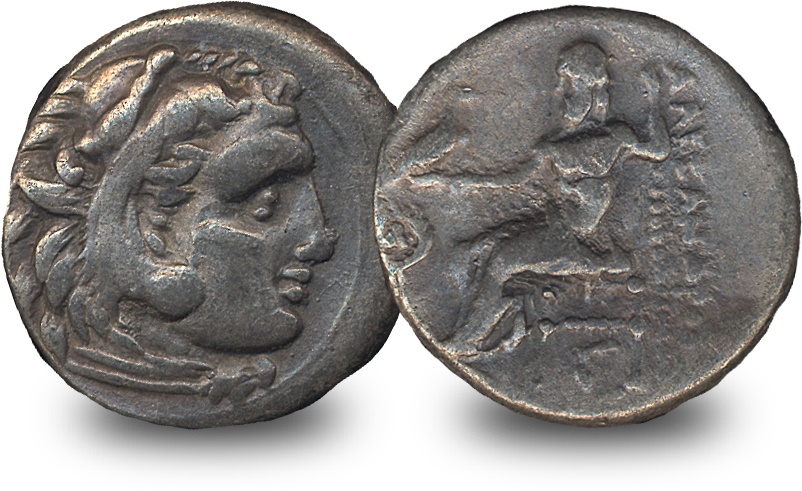World coins
The story of the 1885 Trade Dollar worth millions!
A few years ago, we were asked to identify an unusual coin, which on first glance appeared to be a US Trade Dollar from 1885. However, once we started researching this coin, it became obvious that it must have been a fake.
Here’s why a genuine 1885 Trade Dollar would be impossible to find…
One of the rarest coins on the planet
In 2019, the finest known 1885 Trade Dollar was sold for an eye watering $3.9 million at Heritage Auctions! Whilst this US coin may not be familiar to UK Change Checkers, it is incredibly rare – perhaps one of the rarest coins on the planet.

The US Trade Dollar was designed by William Barber and features Lady Liberty seated on a pedestal of merchandise, facing across the sea and holding an olive branch. On the reverse, an eagle holds branches laden with berries within its talons – an iconic American image. This design remained unchanged besides minor modifications up until the last coin of the series was struck.
Creation of the Trade Dollar
Made from .900 Silver, these coins were struck primarily for trade with Asia and were competing against the other large silver trade coins which had already become popular in the East.

The 1873 Coinage Act made these coins legal tender for payments up to five dollars and many made their way into American commercial channels, despite the majority being sent to Asia.
As their distribution across America became more widespread and the price of silver fell, the coins were demonetised, although many 1873 – 1883 Trade Dollars can still be found on the secondary market today and are often sought-after by US collectors.
The greatest numismatic mystery…
In 1878, production of circulation strikes officially stopped. The Philadelphia Mint continued to strike Trade Dollars after this, however the coins were only issued in proof quality for numismatic purposes.

Credit: Moses King, Public domain, via Wikimedia Commons
It was initially believed that the final year of production was 1883, however over two decades later, 1884 and 1885 dated Trade Dollars created a sensation when they appeared on the secondary market.
Incredibly, just 10 1884 proof quality Trade Dollars were struck and more astonishing still is that only 5 of these coins were struck in 1885!
Imagine how exciting it would have been to first find out about these secret coins, and how desperate American collectors must have been to get their hands on one!
Lack of documentation means the origins behind their creation still remains one of the greatest numismatic mysteries… It’s actually thought that employees from the Philadelphia Mint secretively struck the coins after production was halted.
Sold for $3.9 million!
All 5 coins from 1885 are now accounted for and are owned in private collections, meaning the public rarely get the chance to see these coins exhibited.
A few of the 1885 Trade Dollars have sold at private auction, reaching phenomenal prices. One of the finest specimens from the Eliasberg Collection appeared at Heritage Auctions in 2019 and sold for $3.9 million!
President of Heritage Auctions, Greg Rohan said, “Owning the finest-known [1885 Trade Dollar] specimen is to own an enduring symbol of numismatic and American history.”

So, whilst the 1885 Trade Dollar would be an exceptional coin for any collector to come across, as all 5 1885 Trade Dollars are accounted for, the only explanation for the coin we were asked to look at is that unfortunately it must have been a fake.
It really would be amazing to be able to own a coin as rare as this though! What would you do if you came across such a unique coin in your change?
There are so many fascinating stories about different coins from all around the world and if you have a story about a rare or unusual coin, we’d love to hear it!
If you’re interested in coin collecting, our Change Checker web app is completely free to use!

The coins behind the Ancient Greek myths…
Ancient Greek civilisation provided the foundations for Western culture and one of the empire’s most recognised legacies is Greek mythology, which had an extensive influence on arts and literature in the West. Greek myths tended to describe the lives of Greek Gods including their births, victories in battle, love affairs and their connection to certain city-states.
One artifact which pays homage to Greek mythology is Ancient Greek coinage. Greek currency was the first to be minted on an imperial scale and has influenced commerce across the world.
Coins were hugely important as a medium of exchange and an important store of value and source of prestige. Greek coins used a combination of figures, symbols and inscriptions to symbolise each ruler’s territory. Each city state in Ancient Greece was said to be protected by a certain character from Greek mythology and one of the most identifiable features of Greek coinage are the Gods and Goddesses which are struck on many of the coins of the time.
This blog takes a look at some of the most famous myths that were struck on coins from the time, some over 2,000 years old!
Zeus ‘King of the Gods’
Issued in the 2nd century BC this coin depicts Zeus the chief of the gods and believed to be the ruler of mankind. It’s believe that Zeus saved his brothers, Poseidon and Hades, after they had been eaten by their father Cronus. The three of them divided creation between them. As the Father God, Zeus was the dispenser of good and evil and the upholder of morality.
Hercules ‘Son of Zeus‘
Alexander the Great often issued coins depicting himself dressed as Hercules, wearing a headdress made of the scalp of the Nemean lion – one of Hercules’ “12 tests”. Hercules is famed for being the strongest of all mortals. However, his physical power was offset by a lack of intelligence and strong emotions. Many of Hercules’ great deeds occurred while doing penance for stupid acts done in anger or carelessness.
Apollo ‘God of Music’

The Ancient Greek Apollo ‘God of Music’ Coin
This coin is an example of one of many coins issued depicting Apollo, the son of Zeus. Apollo is considered a complex god of many things including music, poetry, art, oracles, archery, plague, medicine, sun, and knowledge. He is often depicted playing the lyre and is represented as an ever youthful god.
Ares ‘God of War’

The Ancient Greek Ares ‘God of War’ Coin
Issued in the 1st Century BC this coin depicts Ares, the God of war and violence. Fittingly the reverse of this coin features a sword. Ares was a superior fighter in battle and caused great bloodshed and destruction, but he also had a reputation for being cowardly.
The Dioscuri ‘Patron Saint of Sailors’

The Ancient Greek Dioscuri ‘Patron Saints of Sailors’ Coin
This coin features the Dioscuri; the twin brothers of Castor and Pollux. Pollux, the son of Zeus, was immortal but Castor was mortal. When Castor was murdered, Pollux asked his father Zeus if he could share his immortality with his brother. So they transformed into the constellation Gemini, able to travel back and forth between Olympus and Hades. They are also known as protectors of sailors, able to calm the seas and winds in storms.
Gorgon ‘Medusa’

The Ancient Greek Gorgon ‘Medusa’ Coin
Medusa was the only mortal of the three powerful winged Gorgon sisters. It is believed that Medusa was transformed into a monster by Athena. Medusa’s hair was made of snakes, although it is depicted as wild leaves on this coin, and she was said to be able to turn people to stone with a glance. She was killed by the hero Perseus, who used the metal of his shield as a mirror to avoid eye contact with Medusa.
Histiaea ‘Patron Saint of Histiaea’

The Ancient Greek Histiaea ‘Patron Saint of Histiaea’ Coin
This small silver coin is known as a “tertobol” and weighs just over 2 grams. It pictures Histiaea, the nymph, on both the obverse and reverse. Histiaea was named after the ancient city of Histiaea on the second largest Greek island, Euboea. Mythical Naiads lived in the lakes here and being immortal, were invited to the assemblies of the gods on Mount Olympus.
Poseidon ‘God of the Sea’

The Ancient Greek Poseidon ‘God of the Sea’ Coin
Poseidon was worshipped as the god of the sea, earthquakes and horses. Poseidon is often portrayed with his best known weapon, the trident, which he used to shake the earth and create storms, causing devastating earthquakes and tsunamis. It is this trident that is featured on the reverse of this coin. The coin was issued by the Syracuse in the 3rd Century BC, as Poseidon was greatly important to them as a maritime city/state.
Tyche ‘Goddess of Cities’

The Ancient Greek Tyche ‘Goddess of Cities’ Coin
Tyche was the personification of fortune and controlled the luck and prosperity of a city. On this coin she is depicted with a crown of city walls and the reverse depicts a cornucopia, a symbol of good fortune. Tyche was said to have carried a large horn containing riches, which she would sporadically spread to individuals and cities. When no cause could be discovered for events such as floods, droughts or political upheaval, they were often attributed to Tyche
I think this just goes to show how historical events, stories and myths are immortalised on coins to be remembered for generations. And in years to come, our own ancestors may look back at the decimal coins from our era as a window into the past…
If you’re interested in coin collecting, our Change Checker web app is completely free to use and allows users to:
– Find and identify the coins in their pocket
– Collect and track the coins they have
– Swap their spare coins with other Change Checkers

Sign up today at: www.changechecker.org/app
Your guide to Guernsey’s rarest coins in circulation… Mintage figures revealed!
Coins from Crown dependencies and overseas British territories can sometimes make an unexpected appearance in our change.
They are identical in size, shape and weight to UK denominations (bar the new 12 sided £1) which means they often find their way into tills and vending machines undetected.
Finding one in your change can be an annoyance on one hand as technically the coins are not legal tender in the UK. On the other hand, from a collecting point of view, new and interesting designs are always a bonus!
Mintage figures for British Isles coins are very hard to track down, but we’ve managed to get hold of the definitive mintage figures for Guernsey to show you which are the rarest coins you should be looking out for.
Guernsey Definitive 50p Coin Mintage Figures

* These figures have been compiled from historic records in order to provide information to persons who inquire from time to time. All figures are provided as a matter of interest only and for no other purpose. It must be distinctly understood that the States of Guernsey nor its employees can accept responsibility for the accuracy of the figures or for the consequences of any errors or omissions and these figures are supplied under that understanding. [States of Guernsey]
Guernsey’s Definitive 50p Coins
Two different definitive 50p designs have been issued on Guernsey coinage between 1969 and 2012 – the Ducal Cap and Freesia 50p coins.
The first 50p design released in Guernsey, the Ducal Cap, was issued six times between 1969 and 1984, with each coin having a mintage of 200,000.
The coin features an image of the Ducal Cap of the Duke of Normandy on the reverse and the Guernsey Coat of Arms on the obverse, which includes three lions instead of Queen Elizabeth II’s portrait. This makes the 50p particularly distinguishable.

Guernsey Ducal Cap 50p. Issued from 1969-1984
Whilst the Ducal Cap 50ps have a fairly high mintage figure considering the size of Guernsey’s population (just 62,307 as of 2018), the most common Guernsey 50p is actually the 1997 Freesia design with a mintage of 1,044,000.
The Freesia 50p features the Guernsey Freesia Flowers on the reverse and the portrait of Queen Elizabeth II on the obverse. There is also a small Guernsey Coat of Arms on the obverse of the coin, which acts like a Guernsey mint mark and makes the Guernsey 50p stand out when compared to typical UK 50p coins.

Guernsey Freesia Flowers 50p. Issued from 1985 – 2012
Mintage figures for the Freesia design vary considerably, with the rarest coin issued in 1987 actually only having a mintage of 5,000. Mintage figures for the UK Britannia 50p were also low in 1987, as this coin had a mintage of 88,659, whereas the definitive 50p is normally issued in the millions. However the Guernsey Freesia Flowers 50p is still over 17 times rarer than it’s UK counterpart for 1987.
The most common Guernsey 50p, the 1997 Freesia Flowers has a mintage of 1,044,000, however this is still lower than the rarest UK definitive 50p (2017 Royal Shield), which has a mintage of 1,800,000.
Guernsey Definitive £2 Coin Mintage Figures

Guernsey’s Definitive £2 Coin
The first definitive Guernsey £2 coin design was actually dated 1997, but was only included in brilliant uncirculated and proof coin sets.
It was in 1998 that the first of the Guernsey £2 coins were issued in to general circulation, featuring the definitive Flag design.

Guernsey Flag £2 Issued from 1998 – 2012
As the first year of issue for the first bi-metallic coin, you’d expect the mintage for this to be high, however only 150,000 of these coins were struck in 1998. This makes the 1998 £2 Guernsey’s most common definitive £2 in circulation, but when compared to the UK’s most common £2 (1998 Technology design) which had a mintage of 91,110,375, you realise just how rare these Guernsey coins really are!
This design has remained the same since its introduction, however the mintages figures for subsequent years were drastically lower, with the rarest coin being released in 2012 with a mintage of just 5,250. Comparatively, the UK’s definitive £2 coin (Technology design) issued in 2012 had a mintage of 3,900,000 – that’s over 700 times more than the definitive coins issued in Guernsey that year!
Although £2 coins were issued in Guernsey in 1991, 1993, 1994 and 1995, these were actually commemorative crown size coins, not issued for circulation and so we do not have these figures. At that time The Royal Mint manufactured Guernsey’s commemorative coins, creating a crown size denomination from the £2 coin.
Guernsey Definitive £1 Coin Mintage Figures

* These figures have been compiled from historic records in order to provide information to persons who inquire from time to time. All figures are provided as a matter of interest only and for no other purpose. It must be distinctly understood that the States of Guernsey nor its employees can accept responsibility for the accuracy of the figures or for the consequences of any errors or omissions and these figures are supplied under that understanding. [States of Guernsey]
Guernsey’s Definitive £1 Coins
Three different definitive £1 designs have been issued in Guernsey since 1981 – the Lily, HMS Crescent and Finance Motif.
As you can see from the chart above, the Finance Motif design issued from 1985 – 2012 has dramatically lower mintage figures and has been issued more frequently.
The coin features the finance motif on the reverse, but as with most Guernsey coins, it is the unusual obverse that makes it stand out. The obverse features the portrait of Her Majesty the Queen facing right, with a small Guernsey Coat of Arms on the left.

Guernsey Finance Motif £1. Issued from 1985-2012
In 1981, Guernsey issued the Lily £1. Similar to the Ducal Cap 50p, the Lily £1 features the Guernsey Coat of Arms on the obverse, which includes three lions instead of Queen Elizabeth II’s portrait. The reverse of the design features a lily flower, the national flower of Guernsey.
200,000 Guernsey Lily £1 coins were issued in 1981, making it the second most common £1 on Guernsey.

Guernsey Lily £1. Issued in 1981
In 1983, Guernsey issued the HMS Crescent £1.This coin also features the Guernsey Coat of Arms on the obverse, but the reverse features an engraving of the HMS Crescent by Robert Elderton.
This is the most common Guernsey £1, with a mintage of 267,000. But, compared to the most common UK £1 (2015 Royal Arms) which has a mintage of 129,616,985, mintage figures for the HMS Crescent £1 are incredibly low. Almost 500 times lower than the most common UK £1!

Guernsey HMS Crescent. Issued in 1983
Although the 1981 Lily and 1983 HMS Crescent designs were only issued for one year each, they both have much higher mintage figures than the Finance Motif issued prior to these designs.
In fact, if you were to add up the mintages for every year the Finance Motif was issued (bar an unusually high year in 2001) the figure would still be lower than the 1981 Lily and 1983 HMS Crescent coins.
The rarest Guernsey £1 is the 1990 Finance Motif, with a mintage of just 3,500. We know that British Isles mintage figures are much lower than the UK due to the smaller population, however when you compare this to the rarest UK £1 which is the 2011 Edinburgh £1 with a mintage of 935,000, the difference is staggering! In fact, Guernsey’s rarest £1 is actually more than 250 times rarer than the Edinburgh £1!
Lack of Demand for New Definitive Coins
From 2012 to present there have been no definitive coins released on Guernsey, and we must assume that this is due to the fact that there just isn’t the demand for them. As previously mentioned, the small population of just 62,307 means that there are less coins issued on the British Isles.
Has any Guernsey coinage found its way into your pocket and have you been lucky enough to find any of the rarer coins? Let us know in the comments below.
Start your Guernsey coin collection!

You can now order your very own coins from Guernsey to kick start your collection!
Secure the Ducal Cap 50p, Freesia Flowers 50p or Finance Motif £1 here >>


